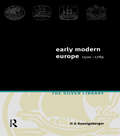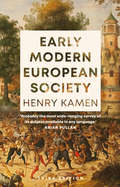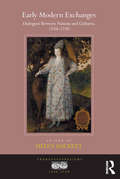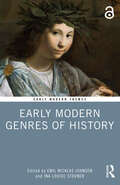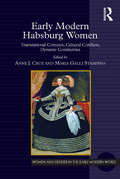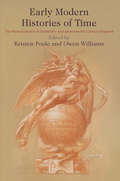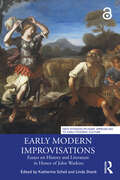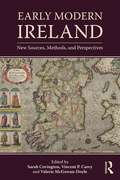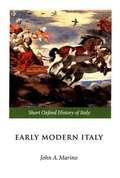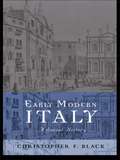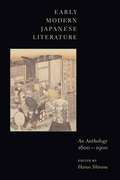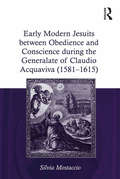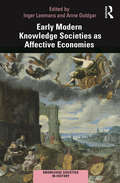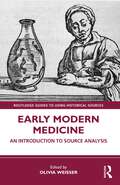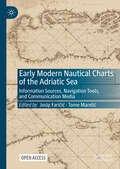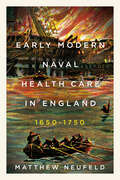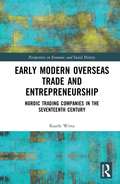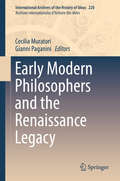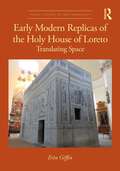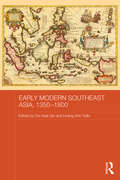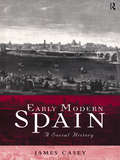- Table View
- List View
Early Modern Europe 1500-1789 (Silver Library)
by H.G. KoenigsbergerOpening at the height of the Renaissance, the book chronicles the dawning of a new age on the European continent. Koenigsberger paints a detailed picture of the Reformation and its significance as increasingly powerful nations began to intrude on their subjects’ public and private lives. He gives account of the Counter-Reformation and the political and economic crisis that accompanied it, and an in-depth discussion of the age of Louis XIV and the balance of power in Europe. A full chapter addresses the Scientific Revolution and the Enlightenment, and throughout attention is given to social, cultural and intellectual developments. The book concludes with a summary of the situation throughout Europe on the eve of the French Revolution, and the dramatic changes brought about by the Industrial Revolution and the beginnings of a consumer society.
Early Modern Europe, 1450–1789 (Cambridge History of Europe)
by Merry E. Wiesner-HanksCovering European history from the invention of the printing press to the French Revolution, the third edition of this best-selling textbook is thoroughly updated with new scholarship and an emphasis on environmental history, travel and migration, race and cultural blending, and the circulation of goods and knowledge. Summaries, timelines, maps, illustrations, and discussion questions illuminate the narrative and support the student. Enhanced online content and sections on sources and methodology give students the tools they need to study early modern European history. Leading historian Merry Wiesner-Hanks skillfully balances breadth and depth of coverage to create a strong narrative, paying particular attention to the global context of European developments. She integrates discussion of gender, class, regional, and ethnic differences across the entirety of Europe and its overseas colonies as well as the economic, political, religious, and cultural history of the period.
Early Modern European Society
by Henry KamenA new edition of a seminal work—one that explores crucial changes within Europe from the fifteenth to the eighteenth century The early modern period was one of profound change in Europe. It was witness to the development of science, religious reformation, and the birth of the nation state. As Europeans explored the world—looking to Asia and the Americas for new peoples and lands—their societies grew and adapted. Eminent historian Henry Kamen explores in depth the issues that most affected those living in early modern Europe—from leisure, work, and migration to religion, gender, and discipline—and the way in which population change impacted the aristocracy, the bourgeoisie, and the poor. The third edition of this pioneering study includes new and updated material on gender, religion, and population movement. Richly illustrated, this is essential reading for all those interested in early modern European society.
Early Modern Exchanges: Dialogues Between Nations and Cultures, 1550-1750 (Transculturalisms, 1400-1700)
by Helen HackettMarcus Gheeraerts’s portrait of a ’Persian lady’ - probably in fact an English lady in masquing costume - exemplifies the hybridity of early modern English culture. Her surrounding landscape and the embroidery on her gown are typically English; but her head-dress and slippers are decidedly exotic, the inscriptions beside her are Latin, and her creator was an ’incomer’ artist. She is emblematic of the early modern culture of exchange, both between England and its neighbours, and between Europe and the wider world. This volume presents fresh research into such early modern exchanges, exploring how new identities, subjectivities and artefacts were forged in dialogues and encounters between diverse cultures, nations and language communities. The early modern period was a time of creative interactions between cultures and disciplines, and accordingly this is a multidisciplinary volume, drawing together international experts in literature, history, modern and ancient languages and art history. It understands cultural exchange as encompassing both the geographical mobilities of travel and trade and the transmission of ideas across borders and between languages, as enabled by the new technology of print. Sites of exchange were located not only in distant and unfamiliar lands, but also in the bookseller’s shop and the scholar’s study. The volume also explores the productive and complex dialogues between early modern culture and the classical past. The types of exchanges discussed include the linguistic transactions of translation and imitation; interactions between cultural elites, such as monarchs, courtiers and diplomats; and the catalytic influences of particularly mobile or outward-looking individuals and groups. Ranging from the neo-Latin poetry of an English author to the plays of a nun in seventeenth-century New Spain, from royal portraits exchanged in diplomatic negotiations to travelling companions in the Ottoman Empire, the volume sheds new light
Early Modern Genres of History (Early Modern Themes)
by Emil Nicklas Johnsen Ina Louise StovnerBringing together an international group of literary scholars, intellectual historians, and cultural historians, this book discusses history in its various forms, either as texts or images in the early modern period (1500–1800).Early Modern Genres of History explores different genres and representational modes regarded as history before history became a scientific discipline during the nineteenth century. It does not seek to show how the modern discipline of history as an academic study developed, but rather to examine the ways in which historical texts and images became part of a wider field of early modern knowledge formations. This volume demonstrates how history was connected to the developments in the public sphere, how antiquarian historians used genres in their work, how history evolved and functioned in the visual field, and how historical genres travelled across different contexts. Overall, Early Modern Genres of History reveals how the diversity of historical representations in the early modern period has contributed to the broader foundations of history as it is understood in the twenty-first century.This volume is of great use to upper-level undergraduates, postgraduates, and scholars interested in early modern Europe and the history of knowledge across both the history and literature disciplines.
Early Modern Habsburg Women: Transnational Contexts, Cultural Conflicts, Dynastic Continuities (Women and Gender in the Early Modern World)
by Anne J. Cruz Maria Galli StampinoAs the first comprehensive volume devoted entirely to women of both the Spanish and Austrian Habsburg royal dynasties spanning the sixteenth and the seventeenth centuries, this interdisciplinary collection illuminates their complex and often contradictory political functions and their interrelations across early modern national borders. The essays in this volume investigate the lives of six Habsburg women who, as queens consort and queen regent, duchesses, a vicereine, and a nun, left an indelible mark on the diplomatic and cultural map of early modern Europe. Contributors examine the national and transnational impact of these notable women through their biographies, and explore how they transferred their cultural, religious, and political traditions as the women moved from one court to another. Early Modern Habsburg Women investigates the complex lives of Philip II’s daughter, the Infanta Catalina Micaela (1567-1597); her daughter, Margherita of Savoy, Vicereine of Portugal (1589-1655); and Maria Maddalena of Austria, Grand Duchess of Florence (1589-1631). The second generation of Habsburg women that the volume addresses includes Philip IV’s first wife, Isabel of Borbón (1602-1644), who became a Habsburg by marriage; Rudolph II’s daughter, Sor Ana Dorotea (1611-1694), the only Habsburg nun in the collection; and Philip IV’s second wife, Mariana of Austria (1634-1696), queen regent and mother to the last Spanish Habsburg. Through archival documents, pictorial and historical accounts, literature, and correspondence, as well as cultural artifacts such as paintings, jewelry, and garments, this volume brings to light the impact of Habsburg women in the broader historical, political, and cultural contexts. The essays fill a scholarly need by covering various phases of the lives of early modern royal women, who often struggled to sustain their family loyalty while at the service of a foreign court, even when protecting and preparing their heirs for rule a
Early Modern Histories of Time: The Periodizations of Sixteenth- and Seventeenth-Century England
by Kristen Poole Owen WilliamsEarly Modern Histories of Time examines how a range of chronological modes intrinsic to the sixteenth and seventeenth centuries shaped the thought-worlds of those living during this time and explores how these temporally indigenous models can productively influence our own working concepts of historical period. This innovative approach thus moves beyond debates about where we should divide linear time (and what to call the ensuing segments) to reconsider the very concept of "period." Bringing together an eminent cast of literary scholars and historians, the volume develops productive historical models by drawing on the very texts and cultural contexts that are their objects of study. What happens to the idea of "period" when English literature is properly placed within the dynamic currents of pan-European literary phenomena? How might we think of historical period through the palimpsested nature of buildings, through the religious concept of the secular, through the demographic model of the life cycle, even through the repetitive labor of laundering? From theology to material culture to the temporal constructions of Shakespeare, and from the politics of space to the poetics of typology, the essays in this volume take up diverse, complex models of sixteenth- and seventeenth-century temporality and contemplate their current relevance for our own ideas of history. The volume thus embraces the ambiguity inherent in the word "contemporary," moving between our subjects' sense of self-emplacement and the historiographical need to address the questions and concerns that affect us today.Contributors: Douglas Bruster, Euan Cameron, Heather Dubrow, Kate Giles, Tim Harris, Natasha Korda, Julia Reinhard Lupton, Kristen Poole, Ethan H. Shagan, James Simpson, Nigel Smith, Mihoko Suzuki, Gordon Teskey, Julianne Werlin, Owen Williams, Steven N. Zwicker.
Early Modern Improvisations: Essays on History and Literature in Honor of John Watkins (New Interdisciplinary Approaches to Early Modern Culture)
by Katherine Scheil Linda ShenkWith a panoramic sweep across continents and topics, Early Modern Improvisations is an interdisciplinary collection that analyzes the relationship between early modern literature and history through lenses such as gender, ethnicity, sexuality, religion, and politics.The book engages readers interested in texts that range from Shakespeare and Tudor queens to Anglican missionary work in North America; from contemporary feminist television series to Ancient Greek linguistic and philosophical concepts; from the delicate dance of diplomatic exchange to the instabilities of illness, food insecurity, and piracy. Its range of contributions encourages readers to discover their own intersections across literary and historical texts, a sense of discovery that this collection’s contributors learned from its dedicatee, John Watkins, a major literary and cultural historian whose work moves effortlessly across geographical, temporal, and political borders. His work and his personality embody the spirit of creative improvisation that brings new ideas together, allowing texts and figures of history to haunt later eras and encourage new questions.This volume is aimed at scholars and students alike who wish to explore early modern culture and its reverberations in ways that engage with a world outside the grand narratives and centralized institutions of power, a world that is more provisional, less scripted, and more improvisational.Chapter 1 of this book is freely available as a downloadable Open Access PDF at http://www.taylorfrancis.com under a Creative Commons [Attribution-Non Commercial (CC-BY-NC)] 4.0 license.
Early Modern Ireland: New Sources, Methods, and Perspectives (Countries in the Early Modern World)
by Sarah Covington Valerie McGowan-Doyle Vincent CareyEarly Modern Ireland: New Sources, Methods, and Perspectives offers fresh approaches and case studies that push the field of early modern Ireland, and of British and European history more generally, into unexplored directions. The centuries between 1500 and 1700 were pivotal in Ireland’s history, yet so much about this period has remained neglected until relatively recently, and a great deal has yet to be explored. Containing seventeen original and individually commissioned essays by an international and interdisciplinary group of leading and emerging scholars, this book covers a wide range of topics, including social, cultural, and political history as well as folklore, medicine, archaeology, and digital humanities, all of which are enhanced by a selection of maps, graphs, tables, and images. Urging a reevaluation of the terms and assumptions which have been used to describe Ireland’s past, and a consideration of the new directions in which the study of early modern Ireland could be taken, Early Modern Ireland: New Sources, Methods, and Perspectives is a groundbreaking collection for students and scholars studying early modern Irish history.
Early Modern Italy 1550-1796 (Short Oxford History of Italy)
by John A. DavisEarly Modern Italian history has traditionally been presented in the context of the absence of a unified Italian state, foreign domination and of relative decline to former wealth and power. This new volume calls on a wealth of recent research to portray the complex history of the early modern Italian states on their own terms. A leading team of historians traces Italian material and cultural bonds of identity and solidarity beyond their common political narrative - from the Reformation through the hopes and frustrations of reform, renewal and restructuring of social and economic power to the eventual collapse of the Old Regime.
Early Modern Italy: A Social History
by Christopher BlackEarly Modern Italy is a fascinating survey of society in Italy from the fifteenth to the eighteenth centuries - the Renaissance to the Enlightenment. Covering the whole of the Peninsula from the Venetian Republic, to Florence, through to Naples it shows how the huge economic, cultural and social divides of the period still affect the stability of present day united Italy.This is an essential guide to one of the most vibrant yet tempestuous periods of Italian history.
Early Modern Japanese Literature: An Anthology, 1600-1900 (Translations from the Asian Classics)
by Haruo ShiraneThis is the first anthology ever devoted to early modern Japanese literature, spanning the period from 1600 to 1900, known variously as the Edo or the Tokugawa, one of the most creative epochs of Japanese culture. This anthology, which will be of vital interest to anyone involved in this era, includes not only fiction, poetry, and drama, but also essays, treatises, literary criticism, comic poetry, adaptations from Chinese, folk stories and other non-canonical works. Many of these texts have never been translated into English before, and several classics have been newly translated for this collection.Early Modern Japanese Literature introduces English readers to an unprecedented range of prose fiction genres, including dangibon (satiric sermons), kibyôshi (satiric and didactic picture books), sharebon (books of wit and fashion), yomihon (reading books), kokkeibon (books of humor), gôkan (bound books), and ninjôbon (books of romance and sentiment). The anthology also offers a rich array of poetry—waka, haiku, senryû, kyôka, kyôshi—and eleven plays, which range from contemporary domestic drama to historical plays and from early puppet theater to nineteenth century kabuki. Since much of early modern Japanese literature is highly allusive and often elliptical, this anthology features introductions and commentary that provide the critical context for appreciating this diverse and fascinating body of texts.One of the major characteristics of early modern Japanese literature is that almost all of the popular fiction was amply illustrated by wood-block prints, creating an extensive text-image phenomenon. In some genres such as kibyôshi and gôkan the text in fact appeared inside the woodblock image. Woodblock prints of actors were also an important aspect of the culture of kabuki drama. A major feature of this anthology is the inclusion of over 200 woodblock prints that accompanied the original texts and drama.
Early Modern Jesuits between Obedience and Conscience during the Generalate of Claudio Acquaviva (1581-1615)
by Silvia MostaccioThe Society of Jesus was founded by Ignatius Loyola on a principal of strict obedience to papal and superiors’ authorities, yet the nature of the Jesuits's work and the turbulent political circumstances in which they operated, inevitably brought them into conflict with the Catholic hierarchy. In order to better understand and contextualise the debates concerning obedience, this book examines the Jesuits of south-western Europe during the generalate of Claudio Acquaviva. Acquaviva’s thirty year generalate (1581-1615) marked a challenging time for the Jesuits, during which their very system of government was called into doubt. The need for obedience and the limits of that obedience posed a question of fundamental importance both to debates taking place within the Society, and to the definition of a collective Jesuit identity. At the same time, struggles for jurisdiction between political states and the papacy, as well as the difficulties raised by the Protestant Reformation, all called for matters to be rethought. Divided into four chapters, the book begins with an analysis of the texts and contexts in which Jesuits reflected on obedience at the turn of the seventeenth century. The three following chapters then explore the various Ignatian sources that discussed obedience, placing them within their specific contexts. In so doing the book provides fascinating insights into how the Jesuits under Acquaviva approached the concept of obedience from theological and practical standpoints.
Early Modern Jewish Civilization: Unity and Diversity in a Diasporic Society. An Introduction (Early Modern Themes)
by David GraizbordThis collection is an introductory historical survey and selective cultural analysis of the development, coalescence, and eventual waning of a diasporic civilization—that of the Jews of the early modern period (ca. 1391–1789) in Europe, the Ottoman Empire, and key nodes of the Iberian Empires in the Americas.Each chapter explores key factors that shaped both distinctive early modern Jewish communities and a remarkably coalescent and far broader community-of-communities. The contributors engage and answer the following questions: What do historians mean by “early modernity,” and to what extent does the concept illuminate the history and culture(s) of Jews from the end of the Middle Ages to the Enlightenment? What were the general demographic contours of the Jewish diaspora over this period and how did they change? How did culture, politics, technology, economics, and gender shape diasporic Jewish communities across eastern and western Europe and the New World over the course of some 400 years? Ultimately, the work renders a portrait of coherence and diversity, continuity and discontinuity, in early modern Jewish life within and across temporal and geographic boundaries.Early Modern Jewish Civilization is essential reading for all students of Jewish history and civilization and early modern history more broadly.
Early Modern Jewry: A New Cultural History
by David B. RudermanA compelling history of the early modern Jewish experienceEarly Modern Jewry boldly offers a new history of the early modern Jewish experience. From Krakow and Venice to Amsterdam and Smyrna, David Ruderman examines the historical and cultural factors unique to Jewish communities throughout Europe, and how these distinctions played out amidst the rest of society. Looking at how Jewish settlements in the early modern period were linked to one another in fascinating ways, he shows how Jews were communicating with each other and were more aware of their economic, social, and religious connections than ever before.Ruderman explores five crucial and powerful characteristics uniting Jewish communities: a mobility leading to enhanced contacts between Jews of differing backgrounds, traditions, and languages, as well as between Jews and non-Jews; a heightened sense of communal cohesion throughout all Jewish settlements that revealed the rising power of lay oligarchies; a knowledge explosion brought about by the printing press, the growing interest in Jewish books by Christian readers, an expanded curriculum of Jewish learning, and the entrance of Jewish elites into universities; a crisis of rabbinic authority expressed through active messianism, mystical prophecy, radical enthusiasm, and heresy; and the blurring of religious identities, impacting such groups as conversos, Sabbateans, individual converts to Christianity, and Christian Hebraists.In describing an early modern Jewish culture, Early Modern Jewry reconstructs a distinct epoch in history and provides essential background for understanding the modern Jewish experience.
Early Modern Knowledge Societies as Affective Economies (Knowledge Societies in History)
by Anne Goldgar Inger LeemansEarly Modern Knowledge Societies as Affective Economies researches the development of knowledge economies in Early Modern Europe. Starting with the Southern and Northern Netherlands as important early hubs for marketing knowledge, it analyses knowledge economies in the dynamics of a globalizing world. The book brings together scholars and perspectives from history, art history, material culture, book history, history of science and literature to analyse the relationship between knowledge and markets. How did knowledge grow into a marketable product? What knowledge about markets was available in this period, and how did it develop? By connecting these questions the authors show how knowledge markets operated, not only economically but also culturally, through communication and affect. Knowledge societies are analysed as affective communities, spaces and practices. Compelling case studies describe the role of emotions such as hope, ambition, desire, love, fascination, adventure and disappointment – on driving merchants, contractors and consumers to operate in the market of knowledge. In so doing, the book offers innovative perspectives on the development of knowledge markets and the valuation of knowledge. Introducing the reader to different perspectives on how knowledge markets operated from both an economic and cultural perspective, this book will be of great use to students, graduates and scholars of early modern history, economic history, the history of emotions and the history of the Low Countries.
Early Modern Medicine: An Introduction to Source Analysis (Routledge Guides to Using Historical Sources)
by Olivia WeisserThis collection offers readers a guide to analyzing historical texts and objects using a diverse selection of sources in early modern medicine. It provides an array of interpretive strategies while also highlighting new trends in the field.Each chapter serves as a study of a different type of source, including the benefits and limitations of that source and what it can reveal about the history of medicine. Contributors provide practical strategies for locating and interpreting sources, putting texts and objects into conversation, and explaining potential contradictions. A wide variety of sources, including account books, legal records, and personal letters, provide new opportunities for understanding early modern medicine and developing skills in historical analysis. Together, the chapters highlight emerging methodologies and debates, while covering a range of themes in the field, from reproductive health to hospital care to household medicine.With wide geographical breadth, this book is a valuable resource for students and researchers looking to understand how to better engage with primary sources, as well as readers interested in early modern history and the history of medicine.
Early Modern Nautical Charts of the Adriatic Sea: Information Sources, Navigation Tools, and Communication Media
by Josip Faričić Tome MarelićThis Open Access book provides a comprehensive and multi-layered understanding of the development of Adriatic Sea nautical cartography from its beginnings in the late Middle Ages to the implementation of geodetic and hydrographic surveys in the early nineteenth century. During the early modern period, the importance of nautical charts exceeded mere navigational purpose as they also became a medium for conveying an extensive array of socioeconomic information and messages. The authors examine how the geographical characteristics and social elements of the Adriatic Sea and its surroundings were observed, understood, and cartographically represented in accordance with contemporary scientific, technological, socioeconomic, cultural, or political frameworks using various phenomenological viewpoints and methodological techniques. Since the Adriatic Sea has historically functioned as a smaller-scale version of the Mediterranean, its contents transcend its geographical boundaries and are also broadly applicable to other Mediterranean regions.
Early Modern Naval Health Care in England, 1650–1750 (McGill-Queen's/AMS Healthcare Studies in the History of Medicine, Health, and Society)
by Matthew NeufeldFrom 1650 to 1750 the provision of medical care for injured seamen in the Royal Navy underwent a major transformation, shifting from care provided by civilians in private homes to care at hospitals run by the navy. Early Modern Naval Health Care in England examines the factors responsible for the emergence of centralized naval health care over the course of a century.In 1650 sick and injured Royal Navy sailors were billeted in homes in coastal communities where civilians were paid to look after them. Care work, which involved making meals and feeding patients, administering medicines, washing clothes and bed linens, and shaving and cutting hair, was essential to the recovery of tens of thousands of seamen – and it was done mostly by women. Beginning at the turn of the eighteenth century, naval health care moved to a more centralized system based in hospitals, where the conduct of sailors and care workers could be overseen. A key factor driving this change was the relationships between naval officials and female civilian caregivers, which were often fraught. Yet even with the shift to naval hospital settings, most care for convalescing sailors continued to be provided by women.Early Modern Naval Health Care in England shines a light on the care work that lay behind England’s formidable Royal Navy during the Age of Sail.
Early Modern Others: Resisting Bias in Renaissance Literature
by Peter C. HermanEarly Modern Others highlights instances of challenges to misogyny, racism, atheism, and antisemitism in the early modern period. Through deeply historicizing early modern literature and looking at its political and social contexts, Peter C. Herman explores how early modern authors challenged the biases and prejudices of their age. By examining the works of Thomas More, William Shakespeare, Christopher Marlowe, John Fletcher, and Philip Massinger amongst others, Herman reveals that for every “-ism” in early modern English culture there was an “anti-ism” pushing back against it. The book investigates “others” in early modern literature through indigenous communities, women, religion, people of color, and class. This innovative book shows that the early modern period was as complicated and as contradictory as the world today. It will offer valuable insight for anyone studying early modern literature and culture, as well as social justice and intersectionality.
Early Modern Overseas Trade and Entrepreneurship: Nordic Trading Companies in the Seventeenth Century (Perspectives in Economic and Social History)
by Kaarle WirtaDrawing on an impressive range of archival material, this monograph delves into the careers of two businessmen who worked for Nordic chartered monopoly trading companies to illuminate individual entrepreneurship in the context of seventeenth-century long-distance trade. The study spans the Caribbean to the Indian Ocean, examining global entanglements through personal interactions and daily trading activities between Europeans, Asian merchants and African brokers. It makes an important contribution to our understanding of the role of individuals and their networks within the great European trading companies of the early modern period. This unique book will be of interest to advanced students and researchers of economic history, business history, early modern global history and entrepreneurship.
Early Modern Philosophers and the Renaissance Legacy
by Gianni Paganini Cecilia MuratoriThis book argues that an abrupt boundary should not divide Renaissance and Early Modern philosophies. Inside, 15 essays explore the transmission of theories through time. The contributors also examine how, in the process, philosophical systems become reinterpreted anew. Often, they acquire new shades of meaning and, even, become different ideas altogether. The essays discuss the question of whether Renaissance thinkers were philosophers in their own right or if they belonged to the history of literature and the arts. The authors also explore why scholars consider Renaissance thinkers separate from modern philosophers. In addition, the book details the legacy of Renaissance philosophers. It traces how later generations interacted with the texts these great minds left behind. Coverage includes the work of Henry More, Girolamo Cardano, Francis Bacon, Bernardino Telesio, René Descartes, Thomas Hobbes, and others. In recent years, a conception of a long Renaissance has emerged. This view extends the end point of the period to include the whole first half of the 17th century. Yet, this sense of continuity usually just stresses the modernity of Renaissance thinkers. This insightful volume presents a deeper portrait. It highlights the Renaissance legacy in early modern thought. In the process, readers will discover new interpretations to this period's great philosophical theories.
Early Modern Replicas of the Holy House of Loreto: Translating Space (Visual Culture in Early Modernity)
by Erin GiffinThis comprehensive and cross-cultural study examines three-dimensional structural replicas of the Santa Casa, or Holy House of the Virgin Mary, and related circulating visual and textual media.Interdisciplinary in its design, the project engages with a broad spectrum of cultures and lay strata, redirecting early modern studies to prioritize anonymously produced Catholic cult objects and devotional memorabilia, disseminated largely between the fifteenth through early nineteenth centuries. By tracing the formation and evolution of Loretan iconography and cult space in two and three dimensions, this publication illuminates the spread of the popular structure as a sculptural cult object and its worship via replication. By combining art historical questions of materiality and form with broader anthropological and social history concerns regarding information production, dissemination, and reception, this book reveals how early modern Catholics capitalized on cult replicas.This book will be of interest to scholars working in art history, architectural history, religious history, and early modern studies.
Early Modern Southeast Asia, 1350-1800 (Routledge Studies in the Modern History of Asia)
by Ooi Keat Gin Hoang Anh TuanThis book presents extensive new research findings on and new thinking about Southeast Asia in this interesting, richly diverse, but much understudied period. It examines the wide and well-developed trading networks, explores the different kinds of regimes and the nature of power and security, considers urban growth, international relations and the beginnings of European involvement with the region, and discusses religious factors, in particular the spread and impact of Christianity. One key theme of the book is the consideration of how well-developed Southeast Asia was before the onset of European involvement, and, how, during the peak of the commercial boom in the 1500s and 1600s, many polities in Southeast Asia were not far behind Europe in terms of socio-economic progress and attainments.
Early Modern Spain: A Social History (Social History Of Europe Ser.)
by James CaseyEarly Modern Spain: A social History explores the solidarities which held the Spanish nation together at this time of conflict and change. The book studies the pattern of fellowship and patronage at the local level which contributed to the notable absence of popular revolts characteristic of other European countries at this time. It also analyses the Counter-Reformation, which transformed religious attitudes, and which had a huge impact on family life, social control and popular culture.Focusing on the main themes of the development of capitalism, the growth of the state and religious upheaval, this comprehensive social history sheds light on changes throughout Europe in the critical early modern period.
